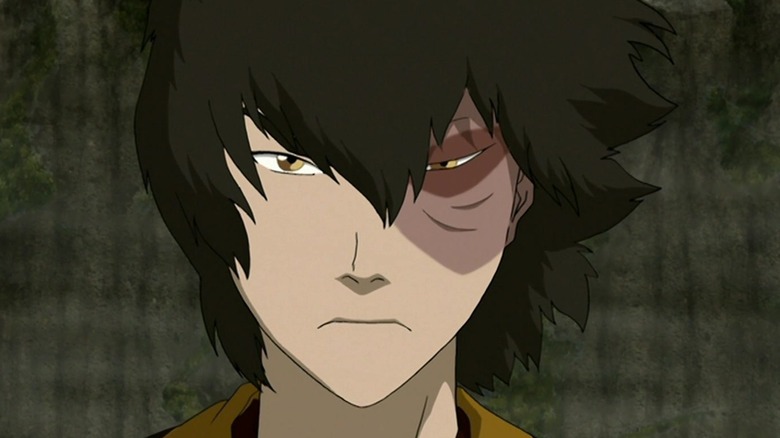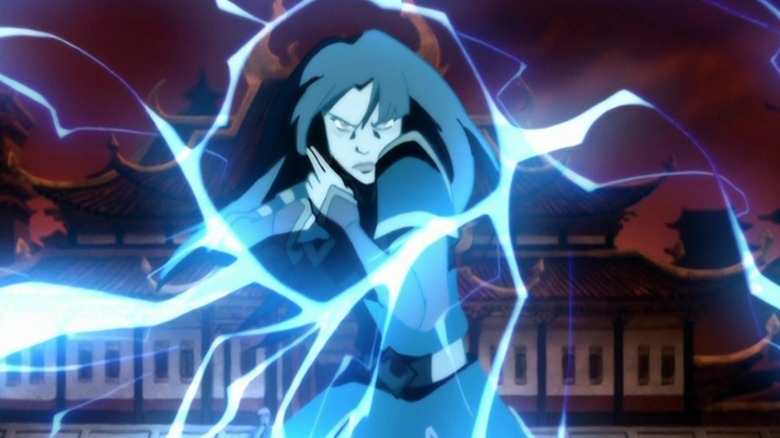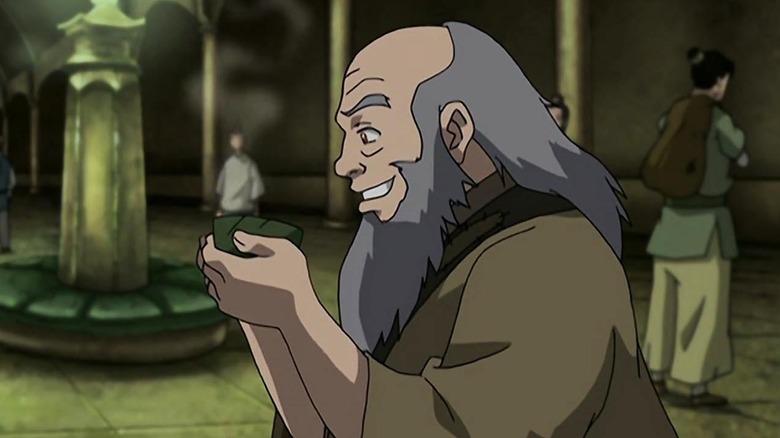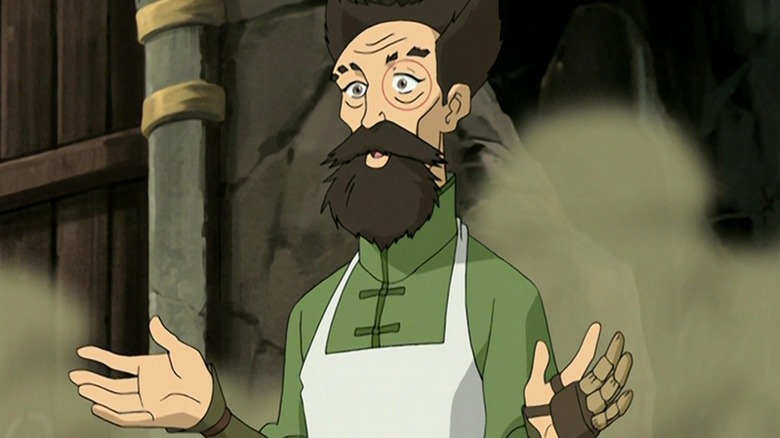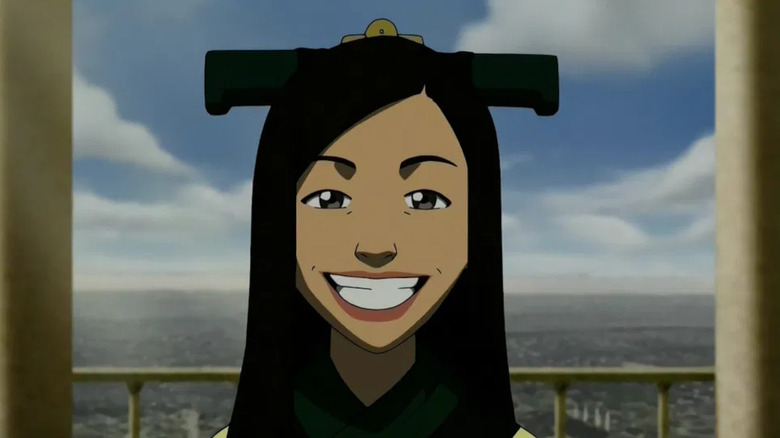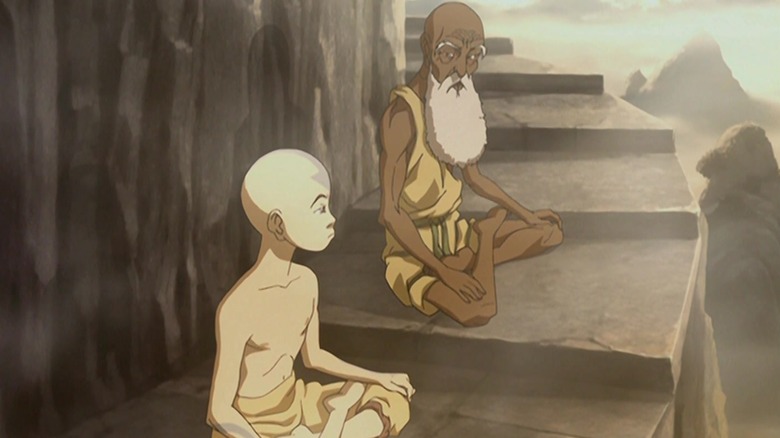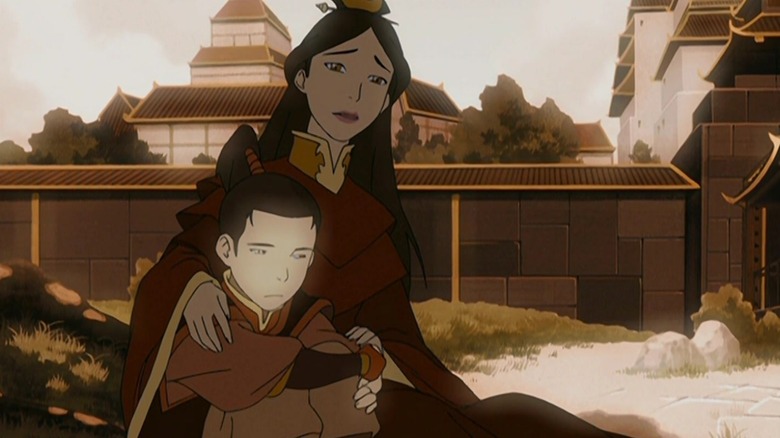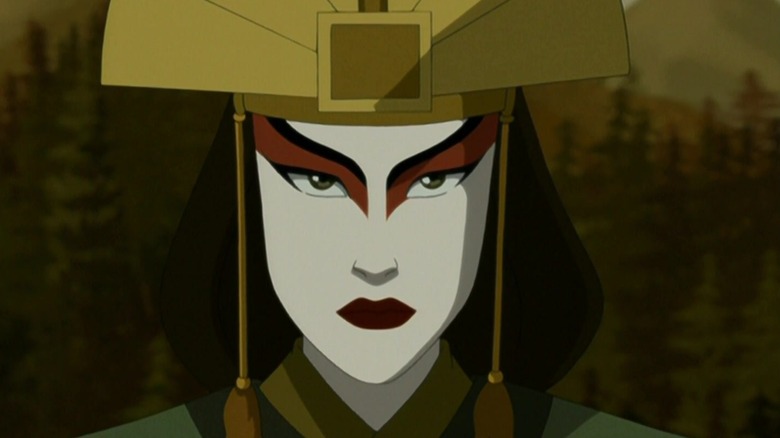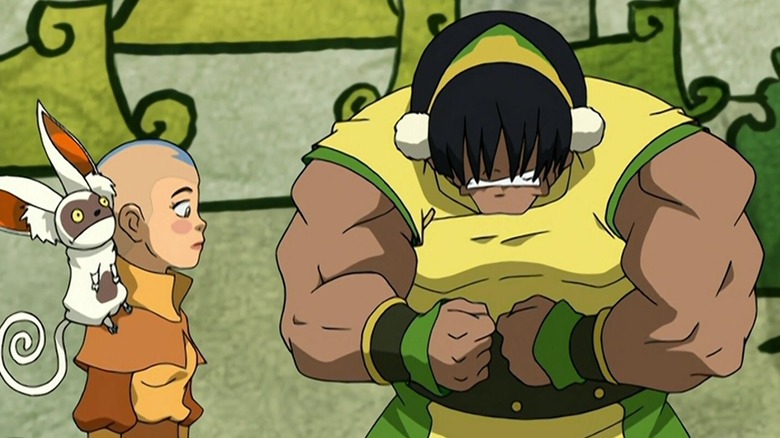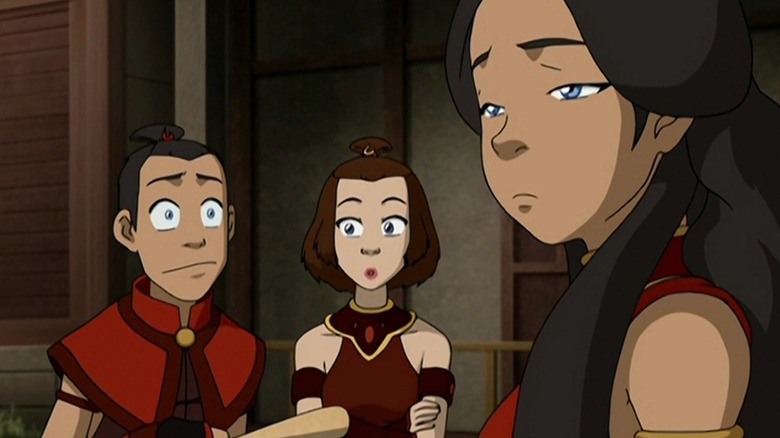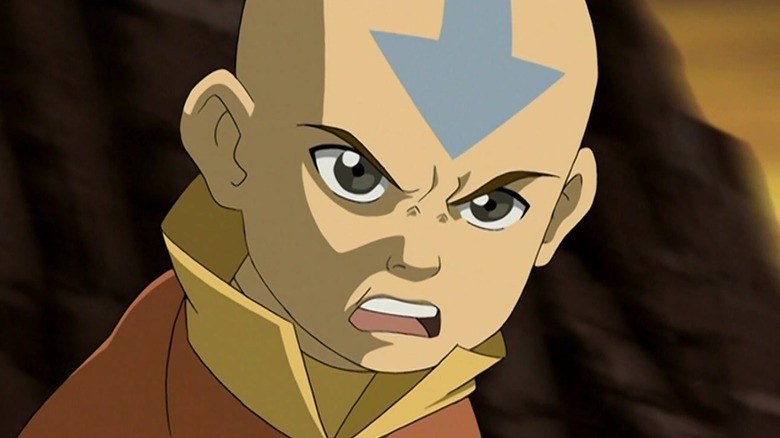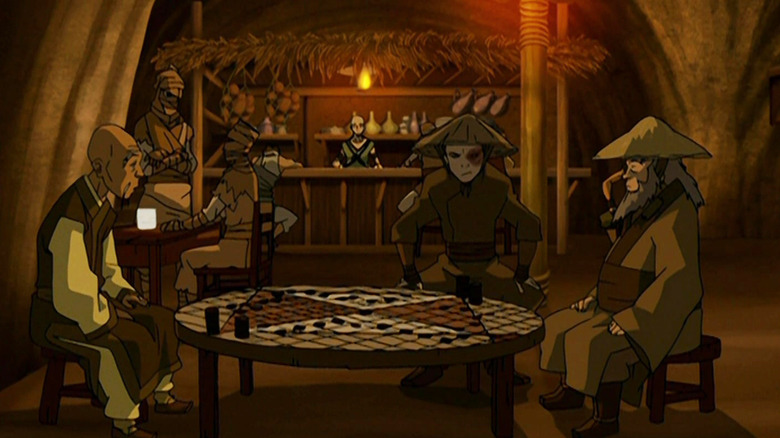The Untold Truth Of Avatar: The Last Airbender
Created by Michael Dante DiMartino and Bryan Konietzko, "Avatar: The Last Airbender" is a groundbreaking animated series that has spawned an entire universe of storytelling. First hitting the airwaves in 2005, this fantasy saga takes place in a world where people can control, or "bend," the core elements of fire, air, water, and earth. While most are confined to bending only one element, the Avatar, who serves as the bridge between the material and spiritual worlds, can bend them all. "Avatar: The Last Airbender" follows Aang, a young Avatar and Air Nomad, as he confronts a world torn apart by war.
Though the series wrapped up in 2008, it cemented an enduring place in the public consciousness as one of the best fantasy stories and animated series of the modern era. As Forbes reported, when it hit Netflix in 2020, it quickly became the streamer's number-one show. It caused such a fuss, in fact, that it spawned something of an "Avatar: The Last Airbender" renaissance. In February 2021, Variety reported that Nickelodeon had established Avatar Studios, a division devoted entirely to this phenomenal fictional world.
By this point, "Avatar: The Last Airbender" is widely regarded as one of the best animated shows ever made. But even long-time fans might not know everything about this fantastic series. From Toph's origins to the real-world roots of chi-blocking, this is the untold truth of "Avatar: The Last Airbender."
Bending is evolving
There are four main types of bending in the world of "Avatar: The Last Airbender": water, earth, air, and fire. But bending isn't as simple as this might imply. Both the series and its sequel, "Avatar: The Legend of Korra," explore the complex origins of several different bending varieties and subtypes.
As series creators Bryan Konietzko and Michael Dante DiMartino revealed to IGN, every style of bending is based on a specific form of kung fu. Waterbending, for example, is based on tai chi, and works in concert with the moon. With proper training and skill, waterbenders can heal illness and injury. They can also bloodbend, which allows them to control others' bodies like puppets. Airbending is similarly multifaceted. Based on baguazhang, airbending allows some practicioners to achieve flight (Zaheer) and project themselves into the Spirit World (Jinora). Firebending, rooted in Northern Shaolin kung fu, is strengthened by comets and weakened by eclipses. Prodigies like Azula can create lightning.
Few styles are as fully explored as earthbending, however. Based on Hung Ga, earthbending is deeply sensory: Toph's blindness actually gives her better perception than most earthbenders, because it roots her so deeply in her sense of touch. Eventually, Toph's skill becomes so great, she invents metalbending. This is so useful that by Korra's time, metalbending practically counts as its own kind of bending. It's used in manufacturing, law enforcement, architecture, and a wide variety of other fields.
Greg Baldwin practiced Mako's voice for 30 years
Legendary actor Mako Iwamatsu, who played fan favorite General Iroh, passed away in 2006. American voice actor Greg Baldwin took over the role, playing the beloved uncle in Season 3 of "Avatar: The Last Airbender." As Baldwin revealed to The Guardian, he first confronted the deep effect Iroh has had on fans of "Avatar: The Last Airbender" at a convention. "Sometimes I would do Iroh's voice and I would see grown men cry," he remarked. "I got a text one time saying: 'I'm sorry to bother you, Mr. Baldwin, but my mother died last night and I was wondering what Uncle Iroh would say to me.' It's a part of the job I never expected."
How did Baldwin get so good at aping Mako's voice? Years of practice. The young Baldwin received a very special birthday gift in 1977: The "Pacific Overture" soundtrack. Mako was nominated for a Tony Award for his performance in this groundbreaking production. Obsessed, Baldwin learned all the songs and developed a strong impression of the actors' voices. As he put it, "I was one of the few people who had been doing an impression of Mako for 30 years."
Interestingly, Baldwin actually inherited numerous roles from Mako, including Aku on "Samurai Jack" and Master Splinter on "TMNT." He has also appeared on "SpongeBob SquarePants," "The Marvelous Misadventures of Flapjack," and "Star Wars: The Clone Wars."
The mechanist's long legacy
After the massacre of the Air Nomads came to its horrific conclusion, the four central air temples stood empty for years. But eventually, a band of displaced Earth Kingdom citizens moved into the Northern Air Temple. This unique group mimics airbending with incredible technology invented by the mechanist, a brilliant engineer who acts as their leader. The unnamed mechanist creates gliders like the Air Nomads once used to ride the wind, time-telling candles, and a number of other wonders.
The world of "Avatar: The Last Airbender" is pretty low-tech. Bending enables certain technological advancements — Ba Sing Se has an earthbender-powered subway system, for example — but by and large, people still light their homes with candles and travel by boat or foot. The mechanist stands out, as a result, and is made even more remarkable in light of "Avatar: The Legend of Korra." Huge technological leaps occur between the two television series: By Korra's time, the feudal world Aang inhabits has become an industrialized landscape full of cars, dirigibles, power plants, and other wonders. As Bryan Konietzko told NPR, "It's kinda set in 1920s fictional Shanghai meets Manhattan."
Would all that development have happened so quickly if it weren't for the mechanist of the Northern Air Temple? No character in all of "Avatar: The Last Airbender" rivals his engineering supremacy, nor his innovative approximation of bending through technology. When Korra jumps into Asami's car, she might have the mechanist to thank.
Ba Sing Se's real-world roots
The world of "Avatar: The Airbender" is a decidedly fantastical one. For one thing, its denizens can control the elements. For another, their animals are whimsically mashed-up versions of very real fauna, resulting in ponds full of turtleducks and glacier-scaling otter penguins. The locations and cultures of this universe are also clearly fictional. But just as the animals of "Avatar: The Last Airbender" combine elements of the real world into brand new creatures, so too do the cultures of the series take inspiration from entirely nonfictional places and eras.
Ba Sing Se is a particularly prominent example. As is detailed in "Avatar: The Last Airbender: The Art of the Animated Series," series creators Michael Dante DiMartino and Bryan Konietzko took a trip to Beijing before settling into production on Season 2. The Great Wall and the Forbidden City served as particularly vivid inspiration for the Earth Kingdom's infamously impenetrable city, which is defined by its enormous walls and strict stratification.
Lake Laogai, the brutal prison where Earth Kingdom dissidents are forcibly re-educated, also has roots in the real world: As detailed by The Atlantic, China's laogai system of prison camps has historically been aimed at harshly re-educating inmates, who have often been imprisoned without trial. No wonder Ba Sing Se is one of the most terrifying locales in all of "Avatar: The Last Airbender."
Chi and chakras
"Avatar: The Last Airbender" is a deeply spiritual show. Michael Dante DiMartino and Bryan Konietzko discussed this explicitly in an interview with Hypable, with particular focus on the Season 2 episode "The Guru." In this installment, Aang struggles with opening his energetic chakras, a process that demands he confront past mistakes and let his worldly bonds dissolve.
Many viewers are utterly unfamiliar with chakras, which DiMartino aknowledged. Some might even assume they're an invention of the show. But in fact, they're a significant part of very real religions, with thousands of years of history behind them. As Encyclopedia Britannica details, the word chakra comes from the Sanskrit word for wheel. Though different branches of Hinduism and Buddhism disagree on the total number of major chakras, they all maintain that they're potent centers of energy located in the human body. Sharp-eyed viewers will also notice that Aang arranges his hands in a traditional mudra position in this episode. Mudras, which are hand gestures with deep symbolic meaning, communicate many different things. The one Aang employs is associated with meditation.
"Avatar: The Last Airbender" explores many other spiritual traditions over the course of its run. Chi is an especially prominent example. A vital concept in Chinese culture, chi is the energy that flows throughout all things. It is the root of all bending, and can be manipulated towards very different ends. Ty Lee, for example, is able to render her opponents completely helpless through chi-blocking techniques.
The story continues in the comics
The series finale of "Avatar: The Last Airbender," the four-part "Sozin's Comet" arc, is well-loved and widely respected for the way it wraps up Aang's story. But fans are still left with a number of fascinatingly loose threads. Does this sound frustrating? Not to worry: Many of these tantalizing paths are explored in the official "Avatar: The Last Airbender" comics.
The second comics arc, "The Search," answers one of the series' most intriguing questions: What happened to Ursa, Zuko and Azula's mother? After finding a hidden letter that throws everything they know into question — including Zuko's claim on the Fire Nation's throne — our heroes (and Azula) journey to Ursa's hometown of Hira'a. Flashbacks fill in the details of Ursa's life and disappearance, answering some questions and asking a few new ones.
In other arcs, Aang, who must contend with a fan club he finds distastefully appropriative, Toph establishes a metalbending academy, and Sokka and Katara confront the urbanization of the Southern Water Tribe. We also see Aang and his allies help build Republic City, a central metropolis where citizens of any nation may gather, and the eventual setting of "Avatar: The Legend of Korra."
LGBTQ+ representation in the world of Avatar
"Avatar: The Legend Korra" made major waves when it ended with Korra and Asami holding hands and gazing into each other's eyes. Shortly after the finale hit the airwaves, Bryan Konietzko took to Tumblr to make their romantic feelings for each other explicitly clear. "Korrasami is canon ... there is no denying it," he wrote. "That is the official story. We received some wonderful press in the wake of the series finale at the end of last week, and just about every piece I read got it right: Korra and Asami fell in love.
Korra and Asami's relationship is a major milestone in animation. But LGBTQ+ representation isn't confined to "Avatar: The Legend of Korra" — it's present in "Avatar: The Last Airbender" as well. In "The Legend of Korra: Turf Wars," Aang and Katara's daughter Kya, a free-spirited waterbender, gives Korra and Asami a rundown of the LGBTQ+ history of their world. Many Air Nomads were gay, she reveals, and felt absolutely no need to hide this fact, as their culture was very supportive. Fire Lord Sozin, in brutal contrast, outlawed same-sex relationships. Historically, the Water Tribes and Earth Kingdoms have been somewhat slow to accept LGBTQ+ people, but progress has been made. She also reveals that Avatar Kyoshi was bisexual, a fact that is explored in far greater detail in the "Rise of Kyoshi" novels.
Zuko and Toph were both nearly adult men
Zuko and Toph are two of the very best "Avatar: The Last Airbender" characters. Who isn't moved by Zuko's arc, which sees him grow from a traumatized teen into a heroic young man? Who doesn't root for Toph Beifong, a pint-sized girl with the earthbending prowess of a colossal badgermole, as she puts the hurt on her opponents in the Earth Rumble ring?
But believe it or not, both Zuko and Toph were almost adult men. As Bryan Konietzko and Michael Dante DiMartino revealed on Dante Basco and Janet Varney's "Braving the Elements" podcast (via Entertainment Weekly), Zuko was initially conceived of as a fully-grown adult in constant pursuit of our heroes. But then, executive producer Eric Coleman asked a critical question: "Wouldn't it be scarier if it was a kid who was really driven?" Thus, Zuko was born.
Toph's original concept was even more of a departure. As Konietzko told Toon Zone, "She was going to be a big, muscular guy ... In fact, the guy in the opening title sequence, the earthbender, was kind of a prototype of Toph, but Aaron Ehasz, the head writer, just really pitched that she should be a girl. And actually, I fought it for a long time, but I totally came on board, and now she's one of my favorite characters." Later, when the Ember Island Players retell our heroes' story in their own ridiculous way, Toph is indeed played by a buff dude.
The creators paid special attention to skin color variation
The creators of "Avatar: The Last Airbender" take character design very seriously. Every denizen of their fictional world has had thought put into their look, whether they wear furry parkas that protect them from the polar winds or hard-edged armor. This effort pays off: "Avatar: The Last Airbender" feels like a very real place full of very real people, informed by a wide variety of nonfictional cultures, places, eras, and events.
Pulling this off is difficult, to say the least. It requires immense research, critical thinking, and a whole lot of design skill. One especially key element is an ironclad respect for and understanding of diversity, which "Avatar: The Last Airbender" has in spades. As Bryan Koneitzko detailed in a Tumblr post, a ton of thought went into character's visual designs, including their skin colors. "Kya's color model shares the exact same skin color as Katara's," he wrote, "Tenzin's skin is a touch darker and less saturated than Aang's; and Bumi's is just about in the middle of his siblings'." Given the huge number of cultures present in this series, it's only right that such attention be paid to characters' skin tones — but few creators put this degree of thoughtfulness into it. This isn't just good storytelling, either: It means more viewers get to see themselves represented in Avatar's heroes.
Aang is a deliberately flawed role model
The Avatar was designed to be a role model from the start. If that surprises you because Aang and Korra are so flawed, the creators understand. But these flaws are actually key to their success as role models. As Michael Dante DiMartino and Bryan Konietzko made clear in an interview with Salon, they take their storytelling responsibilities very seriously. "I totally agree that today's stories have a great opportunity, and responsibility, to help us evolve as individuals and as a society," DiMartino remarked. "I'm fascinated by some of the neuroscience research that's being done on how stories affect our brains ... there is some evidence showing that we are what we watch, or read. Stories really can have a positive or negative influence on the brain and our thoughts."
DiMartino expressed hope that their portrayal of the Avatar encourages viewers to grow towards peace. As many fans can attest, it's had that effect — and capturing Aang's flaws is a key part of that process. A vegetarian pacifist, Aang is playful, compassionate, and empathetic. He's also impulsive, a little selfish, and doesn't always live up to his own ideals. Recall the moment he kills a vulture wasp in the desert by knocking its head off — not exactly a pacifistic act. But Aang is not defined by these lapses, and heads eternally towards enlightenment. If there were no struggle, his growth would mean far less.
There is an official Avatar role-playing game
The world of "Avatar: The Last Airbender" encompasses animated series, comic books, video games, and prose novels. And it's not done growing, either. In fact, there is now an official "Avatar: The Last Airbender" tabletop role-playing game. Magpie Games secured the rights in 2021 and launched a Kickstarter campaign for "Avatar Legends: The RPG" in August of that year. How much does the fandom love the idea of a tabletop game set in Aang's world? So much that the campaign was funded in a jaw-dropping 16 minutes.
Turning this fictional world into a game was a fascinating process, which Magpie Games CEO Mark Truman and lead designer James Mendez Hodes detailed in an interview with Dicebreaker. One particularly interesting core mechanic is Balance, which measures how closely players keep to the larger themes of the game. Given how much of the series is about the struggle to find and maintain balance on an interpersonal, intercultural, and international scale, this seems incredibly appropriate.
Fascinatingly, the game offers players five different eras to operate within: That of Avatar Kyoshi, Avatar Roku, Aang, Korra, and uniquely, the 100 years in which Aang was frozen and the Fire Nation attacked. That's right: You can do an entire "Avatar Legends" campaign without ever having the Avatar show up.
